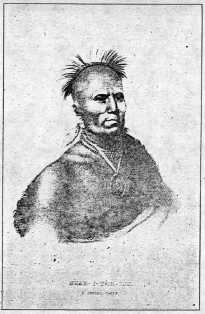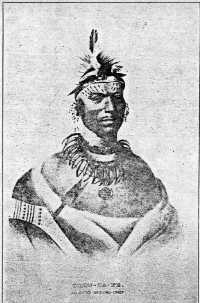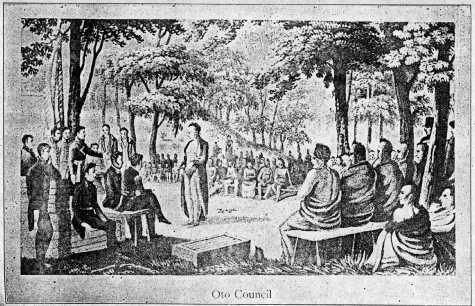|
20 |
|

|
20 |
|

Shar-i-tar-ish was a principal chief of the Grand Pawnee tribe. He was son of another chief of the same name mentioned as Char-ac-tar-ish by Lieutenant Pike who met him at the Grand Pawnee village on the Republican river in 1806. The subject of this portrait succeeded his elder brother, Ta-re-ca-wa-ho as head chief. The latter was invited to visit the president at Washington, but refused because he thought the Pawnee the greatest people on earth and would not condescend to go in person. He sent Shar-i-tar-ish in his stead. Shar-i-tar-ish was then a young man, six feet tall, well proportioned and of fine appearance. His portrait was made at Washington. Soon after his return he became head chief and died a little later, aged thirty. He was succeeded by Ish-ca-te-pi sometimes spelled Is-ka-tap-pi and called "The Wicked Chief."
|
|
21 |
End of Military Note Book.
The last leaves of the record of this journal were evidently lost like those of the beginning. However, as we know that the massacre of the Spaniards took place the day after their meeting with the Optoptata and their allies, there is every ground for supposing that the manuscript ended at the date of August 10, 1720 and that its author was killed the next day.
News of the Massacre Carried to the French.
At any rate the news of the disaster to the expedition was known in all its details at Kaskaskia about the beginning of November. The first rumors of it probably arrived a month earlier, for it seems the same event referred to in the following letter. However, since the Spaniards were not always in a body, the letter may refer to an isolated detachment.
Slavery and Human Sacrifice in Nebraska Region.
"All the nations of the Missouri" wrote
Boisbriant on October 5, 172033, "have made peace with
the Pani-Maha, but they utterly refuse to consider with the
Padoka. The Otoptata and the Canzes have been at war with the
latter (Padoka). They have taken 250 slaves. As in the village
where they have taken these there were many Spaniards, twenty of
these are among the slain. This news has been brought to Sieur
Boisbriant by four Frenchman whom he had given permission to go
and buy horses from the Panyouessa34 (Wichita). Before
the arrival of these French, that nation had also defeated a
village of Padoka. It had led away 100 slaves whom it had burned
without mercy from day to day. Our French ransomed four or five
from the flames, but their generosity was ill rewarded. The
wretches ran away a little later and carried with them, the
clothing of their liberators." and further on "A Spaniard escaped
from the defeat recorded above. He is with the Canzes (Kansas). We
have written a Frenchman who is on the Missouri, to ransom the
Spaniard and bring him this fall to Sieur Boisbriant. He hopes to
draw from the Spaniard information of the commence which the
Spanish carry on with the savages and to learn from him if there
are mines in that region."
|
22 |
|

Chon-ca-pe, sometimes written Shunk-co-pe, was also called "Big Kanzas." He lived in the first half of the 19th century. He was a signer of the treaty of 1825 made at Council Bluffs, between the United States and the Otoe tribe. Soon after he was called to Washington to meet the president. At this visit this portrait was made. The grizzly bear necklace is a trophy of a victory over one of those fierce animals.
|
|
23 |
On November 22, 1720, Boisbriant gave more precise information.
"The Spaniards to the number of 250, accompanied by the Padoka35 nation, came to make an establishment on the Missouri. On the way they defeated five36 nations. The commandant believed, after one splendid victory, he was strong enough to withstand anything. He sent part of his force to conduct the slaves taken in the villages he had destroyed and advanced within 15 leagues of the Otoptata. His plan, was to extirpate that nation. He had with him then 60 Spaniards and 150 Padokas.
Oto Deceive the Spaniards.
The Otoptata, warned by the Pani-Maha of the
Spanish approach, marched to meet him. They called themselves
Pani-Maha, which was rendered easier since they spoke the language
of the Pani-Maha as though their native language. The Spanish
commander, deceived, asked if there were any French on the
Missouri river and assured them that he would give them a great
quantity of goods if they would deliver French into his hands.
They replied that there were French with the Otoptata and that
they would make it easy for him to capture them. They passed the
night together, but in very different ways. The Otoptata danced,
the Padoka fled from fear, while the Spaniards, abandoned by their
allies kept on their guard. The Spaniards feared nothing, since
they trusted in such a great number of the pretended
Pani-Maha.
|
24 |
|

|
|
25 |
Oto Destroy the Spanish Army.
On the next day the savages proposed an
Iroquois dance. The Spaniards agreed and unloaded their mules in
order to rest. About two o'clock in the afternoon the Otoptata
asked for the lances of the Spaniards for their dancers to use in
the dance and they were granted them.37 The chief of
the savages during the dance formed his warriors in groups about
the Spaniards who were always under arms. When he saw everything
arranged as he wished he fired a pistol upon the Spanish. At the
signal all his men attacked with such impetuosity that all the
Spaniards were killed in less than an instant. Only four of them
were quick enough to mount their horses and drive their mules
ahead of them. But some young warriors seized their quivers, shot
and killed two of them.. The two sole survivors of the sixty
Spaniards pushed on toward Mexico, which they could reach with
difficulty deprived as they were of all provisions.
The chaplain of the detachment was made
prisoner. The Otoptata chief was bringing him to Sieur Boisbriant,
but the chief was compelled to turn back on receiving news that
the Renards (Fox) had come to attack his village. A man named
Chevallier was ordered to go in search of the chaplain.
Spaniards Plan to Colonize Nebraska Country.
This undertaking of the Spanish shows the necessity of establishing a post on the Missouri. They brought with them a large number of oxen, cows and sheep, which proves their purpose to make a permanent settlement.
Booty from the Battlefield.
According to Charlevoix there were two
chaplains. "All that was told me" said he "related to the chaplain
who was slain and from whom was taken a book of prayers, which I
have not seen. It was apparently his breviary. I purchased his
pistol, his shoes were worthless, and the savage would not part
with the ointment because when taken it was a sovereign remedy for
all kinds of ills. I was curious to know how he used it and he
replied that it was enough to swallow a little at a time and
whatever illness one had he was instantly cured. He assured me
that he had not yet tried it and I counselled him not to do so. We
find the savages here very coarse. There is much need of
spirituality or at least that their minds should be as open as
those who have had more intercourse with us."
© 2000, 2001 for NEGenWeb Project by Ted & Carole Miller